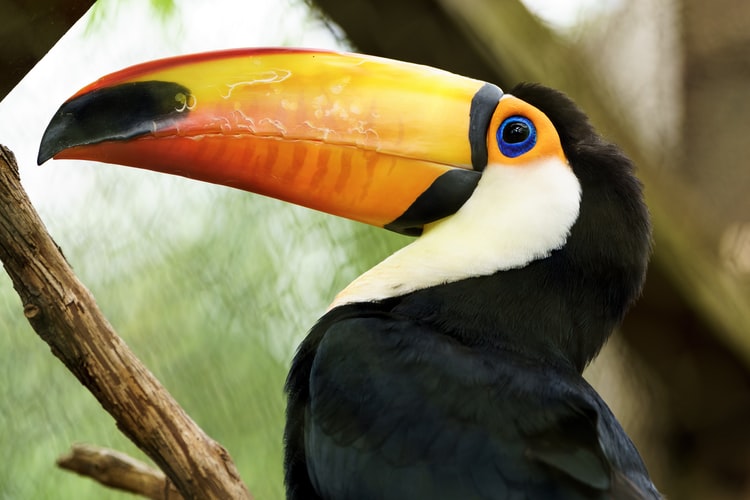
Can you recognize a toucan ? oh yes, definitely! With its colorful and oversized beak, the toucan is one of the most recognizable birds in the world. But did you know how many species of toucans are there ? Do you know, where or how they live?? Well, let me help you with this, to get you some interesting and fun info.
Where do toucans live?
Toucans are found in America (they can be found from the southern part of Mexico to Paraguay and northern Argentina), Asia and Africa.
What do toucans eat?
Most toucans are fruit eaters. There are omnivores that can consume insects and small lizards. They also get food by stealing from foreign nests.
** INTERESTING & FUN FACTS**
- Toucans belong to the woodpecker family of birds.
- There are about 40 different species of toucan.
- Due to their forest lifestyle, they have small wings.
- The characteristic feature of toucans is the unusually colorful and large beak. In some individuals its length may be equal to half the length of the bird’s body. Its edges are serrated. The structure of the beak and its size help toucans regulate their body temperature. It also facilitates the nutrition process. Toucans can eat the fruit without moving. Its colorful coloration has a deterrent effect on other birds. This allows toucans to plunder foreign nests.
- Due to the large size of the beak, it is not able to forge its hollow by itself. They make nests in holes dug by other animals.
- They lead a sedentary lifestyle. They usually live-in pairs or small groups of about 6 individuals.
- Typically, the female lays two to four eggs in her nest. The young hatch after about 16 days. They leave their family nest for the first time about 7 weeks after birth. Between the ages of three and four, they reach sexual maturity. Parents take care of the young.
- During sleep, they curl up into a “ball”.
- Belize’s national bird is the keel-billed toucan. This species is often tamed by the natives. His feathers are used to make plumes.
- Toucans have a long tongue (about 15 cm) resembling a thin feather.
- The largest species is the Toko toucan. The largest specimens are up to 63.5 cm long, and its beak is up to 19 cm long.
- Its colorful coloration serves, inter alia, as a camouflage to help hide among plants.
- They control their body temperature by regulating blood flow to the beak. They fall asleep in the bow to save heat.
- The beak of the young develops as they grow.
- The average life expectancy of these packages is 20 lt.
- The greatest threats to toucans are snakes, jaguars, and humans.
- Even thou they are majestic birds, they and not so great when it comes to flying. This bird ability is poorly developed. They usually move by jumping from tree to tree.
- Despite its considerable size, the beak weighs less than you might think. It consists of protein keratin, which is the same substance from which our hair and nails are made. The beak structure includes many air pockets which allow for an incredibly low weight.
- Toucans are omnivorous birds. Their diet is mostly based on fruit. In addition to fruit, toucans eat berries, seeds, eggs, insects, and small reptiles.
- Even with the destruction of their habitats, the greatest threat to these birds is the pet trade. Their colorful nature makes them extremely attractive, but it threatens their numbers.
- The great toucan lives in the rainforests of South America. These rainforests are rainforests that are close to the equator. They receive large amounts of rainfall each year and are covered with a canopy of trees.
- Toucans spend a lot of time in trees and are not the best flyers. These birds need to flap their wings vigorously to travel short distances, so it is common for them to bounce instead of flying through the air.
- The mascot of the Froot Loops breakfast cereal is actually a toucan, known as the Sam Toucan.
- When Europeans first came to the Americas, the toucan was said to be one of the first birds they saw.
- The bird has a serrated edge of the beak designed to handle food very much like a knife.
- Both males and females have large, brightly colored beaks that can reach 20 cm in length.
- The Great Toucan have a unique appearance. First of all, they are the largest member of the toucan family. Oh, the beaks can be a third of their total length!
- The name “toucan” is derived from the extinct Tupi language of Brazil, which was replaced by Portuguese
- Because of their large beak, toucans are not able to carve out their hollow, they use holes in trees carved by other animals.
- Toucans have a long tongue that resembles a feather.
- Despite its size, the beak of a toucan is noticeably light because it is made of keratin, which is just like human hair. This means that the toucan’s beak is not too strong, so it cannot be used for digging or fighting like other bird beaks.
- Toucans use their beaks to pluck and peel the fruit, which is their main food source. Toucans also sometimes eat the eggs of other birds.
- Some snakes and rodents can attack smaller toucans but are usually more interested in toucan eggs.
- Many indigenous peoples consider toucans to be guides between the world of the living and the spirits.
- Toucans play an important ecological role because they disperse the seeds of the consumed fruit.
- 15. The smallest of these toucans is the yellow-bellied Arasari (Pteroglossus inscriptus), weighs about 130 grams and is about 29 centimeters long.
- The largest toucan (Ramphastos toco) weighs about 680 grams and is about 63 centimeters long.
- Toucans have short wings and do not like to fly.
- Toucans live in small groups of up to 6 birds.
- Toucans are rather lazy birds and like to be in one place. They do not fly high in the sky or far from home, and they like to be in trees with fruit they like to eat.
- The color of the beak may be black, blue, brown, green, red, white, yellow or a combination of these colors.
- A young toucan is incubated for about 20 days, and after birth it has no characteristic beak. It develops as the bird grows.
- To protect themselves, they rely on their loud noises to scare away enemies and alert other toucans of danger.
- When toucans are asleep, they hide their beaks under their feathers to keep them warm.
- Toucans mate once a year. The female lays 2 to 4 eggs in a nest on the tree.
- They spend their lives high in the canopy of the rainforest – they rarely go on trips along the forest floor.
- Although it looks dangerous, the beak of a toucan is actually quite delicate. It can scare other animals away but is not especially useful in fighting them. However, it works well for harvesting food.
- Toucans eat mostly fruit, but occasionally feed on insects and small lizards.
- Toucan is a symbol of fun and intelligence.
- Some people keep toucans like pets.
- Toucans come in brown, red and green colors.
- One of the oldest toucans lived for 26 years.
- The keel-billed toucan ( also know as rainbow billed Toucan) is Belize’s national bird. The natives tame it like a parrot and use its precious feathers to make plumes and ornaments.
- Toucans have sharp and strong claws that allow them to hold onto branches tightly.
- Toucan wings are relatively small, only suitable for short-distance flights.
- The Green Billed Toucan has the smallest beak of a large toucan and is commonly found in the rainforests of Brazil and Argentina.
- Toucans are noisy in the late afternoon when other birds become inactive.
- Both parents take part in the incubation of the eggs, which lasts from 16 to 20 days. Parental care continues after the birds have hatched.
- Lifespan: Toucans can live 12-20 years depending on the species. Larger toucans live in captivity for up to 25 years.
- Their large beak helps them keep them cool in the hot environment in which they live. This adaptation is one of the best heat regulation systems in the entire animal kingdom. The arteries in their beaks expand as the bird becomes hot and release heat.
- Toucans are highly intelligent and trained and can even be trained to go potty in cages. They are friendly and fun.
- The predators they need to watch out for are forest eagles, hawks, and owls. Boa constrictors, jaguars, and weasels often attack their nests.
- Toucans are in fact an endangered species as their habitats are being destroyed by the removal of huge pieces of rainforest. Fortunately, toucans quickly adapt to new environments and are able to survive.
- A toucan does not use wings to fly extremely far. Due to their small size, the wings act more like a glider that allows them to fly short distances.
- Little toucans have no feathers at birth.
- Almost the entire body of a toucan is covered with black feathers, except for the throat, which is covered with white or yellow feathers. The color of the feathers provides camouflage.
- Toucans build their nest in tree hollows created by other animals such as woodpeckers.
- Toucans are among the loudest forest birds. Their chants often resemble crouching frogs. Toucans combine their extensive vocal calls with the tapping and popping sounds of their beaks.
























